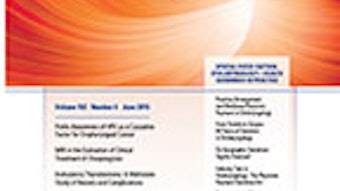PROPOSED CY 2016 MEDICARE PHYSICIAN FEE SCHEDULE (MPFS)What does it mean for you?
On July 8, 2015, the Centers for Medicare & Medicaid Services (CMS) posted the proposed Medicare physician fee schedule (MPFS) for calendar year (CY) 2016. The Academy submitted comments to CMS on the proposed rule on September 8, 2015. The Academy also developed a Member summary, which goes into greater detail of all of the important proposed requirements.

Repeal of Sustainable Growth Rate (SGR)
The CY 2016 MPFS is the first proposed update to the physician payment schedule since the repeal of the SGR through the Medicare Access and CHIP Reauthorization Act of 2015 (MACRA). An incentive payment program, referred to as the Merit-Based Incentive Payment System (MIPS), will replace the SGR in CY 2019 and consolidates three existing incentive programs, the Physician Quality Reporting System (PQRS) program, the Value-Based Modifier (VBM) program, and the Electronic Health Record (EHR) Meaningful Use incentive program.
| ACRONYM | FULL NAME |
| ABLE | Achieving a Better Life Experience Act of 2014 |
| ACA | Affordable Care Act |
| ACOs | Accountable Care Organizations |
| CAHPS | Consumer Assessment of Healthcare Providers and Systems |
| CHIP | Children’s Health Insurance Program |
| CMS | Centers for Medicare and Medicaid Services |
| CY | Calendar Year |
| EHR | Electronic Health Record |
| EP | Eligible Professional |
| GPRO | Group Practice Reporting Options |
| HHS | Health and Human Services |
| IWPUT | Intra-Service Work Per Unit of Time |
| MACRA | Medicare Access and CHIP Reauthorization Act of 2015 |
| MIPS | Merit-Based Incentive Payment System |
| MPFS | Medicare Physician Fee Schedule |
| PAMA | Protecting Access to Medicare Act of 2014 |
| PE | Practice Expense |
| PFS | Physician Fee Schedule |
| PQRS | Physician Quality Reporting System |
| QCDR | Qualified Clinical Data Registry |
| RUC | Value Scale Update Committee |
| RVUs | Relative Value Units |
| SGR | Sustainable Growth Rate |
| VM | Value-Based Modifier |
Professionals will receive an annual update of 0.5 percent in each of the years 2015 through 2019. The rates in 2019 will be maintained through 2025, while providing professionals with the opportunity to receive additional payment adjustments through the MIPS. In 2026 and subsequent years, professionals participating in alternative payment models that meet certain criteria would receive annual updates of 1 percent, while all other professionals would receive annual updates of 0.5 percent. For CY 2016, CMS estimates the CY 2016 MPFS conversion factor to be 36.1096, which reflects a budget neutrality adjustment of .09999 and the 0.5 percent update factor specified under MACRA.
Potentially misvalued services under the fee schedule
CMS and the AMA Relative Update Committee (RUC) have taken increasingly significant steps to address potentially misvalued codes. Under the Affordable Care Act (ACA), the Secretary of United States Department of Health and Human Services (HHS) is directed to examine misvalued services in the seven key categories. In addition to these seven categories, the Protecting Access to Medicare Act of 2014 (PAMA) also added nine new categories that the Secretary must consider in identifying potentially misvalued codes: 1. Codes that account for the majority of spending under the physician fee schedule (PFS); 2. Codes for services with a substantial change in the hospital length of stay or procedure time; 3. Codes for which there may be a change in the typical site of service since the code was last valued; 4. Codes for which there is a significant difference in payment for the same service between different sites of service; 5. Codes for which there may be anomalies in relative value units (RVUs) within a family of codes 6. Codes for services where there may be efficiencies when a service is furnished at the same time as other services; 7. Codes with high intra-service work per unit of time (IWPUT); 8. Codes with high Practice Expense (PE) RVUs; and 9. Codes with high cost supplies.
Reissuance of 2015 potentially misvalued codes under High Expenditure Screen
In the proposed CY 2016 MPFS, CMS re-proposes a new screen that captures codes as potentially misvalued codes and prioritizes the subset of codes that account for the majority of spending under the physician fee schedule. CMS is proposing 118 codes as potentially misvalued codes, identified using the high expenditure screen under the statutory category, “codes that account for the majority of spending under the PFS,” 14 of which are related to otolaryngology.
| HCPCS Short Descriptor | |
| 10022 | Fna w/image |
| 11100 | Biopsy skin lesion |
| 11101 | Biopsy skin add-on |
| 31500 | Insert emergency airway |
| 31575 | Diagnostic laryngoscopy |
| 31579 | Diagnostic laryngoscopy |
| 31600 | Incision of windpipe |
| 70491 | CT soft tissue neck w/dye |
| 70543 | MRI orbt/fac/nck w/o &w/dye |
| 76536 | US exam of head and neck |
| 92557 | Comprehensive hearing test |
| 92567 | Tympanometry |
| 95004 | Percut allergy skin tests |
| 95165 | Antigen therapy services |
| *Note: CMS excluded E/M services from the list of proposed potentially misvalued codes for the same reasons that CMS excluded them in a similar review in CY 2012. | |
Improving valuation of the global surgical package (p. 80)
In the final 2015 MPFS rule, CMS made a major change to reporting global surgical procedures by implementing a two-year transition of all 010 and 090 global services to a 000 global. MACRA prohibits HHS from implementing this change. However, HHS may revalue misvalued codes for specific surgical services or assign values to new or revised codes for surgical services, and MACRA requires CMS to develop a process to gather information needed to value surgical services from a representative sample of physicians, and requires that the data collection shall begin no later than January 1, 2017.
The collected information must include the number and level of medical visits furnished during the global period and other items and services related to the surgery, as appropriate. This information must be reported on claims at the end of the global period or in another manner specified by the Secretary. Every four years, CMS must reassess the value of this collected information. CMS can discontinue the collection once they have adequate information from other sources to accurately value global surgical services.
Beginning in CY 2019, CMS must use the information collected as appropriate, along with other available data, to improve the accuracy of valuation of surgical services under the physician fee schedule (PFS). MACRA gives HHS the authority to delay up to 5 percent of the payment for services for which a physician is required to report information in cases where they do not report.
Target for relative value adjustments for misvalued services (p. 97)
PAMA requires CMS to establish an annual target for reductions in PFS expenditures resulting from adjustments to relative values of misvalued codes. If the estimated net reduction in expenditures for a year is equal to or greater than the target for the year, reduced expenditures attributable to the adjustments will be redistributed in a budget-neutral manner within the PFS in accordance with the existing budget neutrality requirement. This means that for a given year, CMS is to net all reductions to misvalued codes. If the reductions do not hit the target amount, then as per normal, the reductions are distributed.
Initially, PAMA set the target at 0.5 percent of the estimated amount of expenditures under the PFS for CY 2017-CY 2020. However, the Achieving a Better Life Experience Act of 2014 (ABLE) amended the targets to 1 percent for CY 2016 and 0.5 percent for CY 2017 and CY 2018. In the proposed MPFS, CMS has reached 0.25 percent of the target, meaning CMS needs to reach another 0.75 percent to meet the accelerated target. CMS proposes to use a phase in of significant relative value units (RVUs) over two years to meet the target. If CMS does not reach the target, CMS will redistribute a negative 0.75 percent reduction to all codes in the MPFS.
Quality reporting initiatives
The proposed MPFS details changes to quality initiatives, including PQRS and Physician Compare. For a detailed look at all program changes in the proposed rule, please refer to the Academy’s summary at: www.entnet.org/content/regulatory-advocacy. Highlights of CMS’ proposed changes to quality programs are detailed here.
Physician Compare website (p. 370)
The Physician Compare website provides information to the public on physicians enrolled in the Medicare program as well as other EPs who participate in PQRS. To the extent that scientifically sound measures are available, Physician Compare includes measures collected as part of PQRS, as well as assessments of patient health outcomes; continuity and coordination of care and care transitions; efficiency; patient experience and patient, caregiver, and family engagement; and safety, effectiveness, and timeliness of care. CMS proposes to add the following to the Physician Compare website:
- A green check mark on the profile page for individuals and groups who receive an upward adjustment for the value modifier (VM)
- All PQRS Group Practice Reporting Options (GPRO) measures, as well as measures reported by Shared Savings Program Accountable Care Organizations (ACOs), including CAHPS for ACO measures
- All group practice QCDR measure data
- A benchmark used to assign stars for the Physician Compare 5 star rating
Physician Quality Reporting System (PQRS) (p. 397)
The proposed rule also details CMS proposed changes to the 2018 PQRS payment adjustment, which will be determined by an eligible professional’s (EP) or group practice’s reporting of quality measures data from January 1, 2016, to December 31, 2016. The PQRS payment adjustment for 2018 for failure to meet the PQRS reporting requirements for the applicable reporting period is -2 percent. As mandated by MACRA, future payment adjustments will be determined by MIPS once the PQRS program concludes in 2018.
CMS has issued the following proposed changes, which may affect PQRS reporting for otolaryngologist-head and neck surgeons:
- Groups of 25+ Eligible Professionals (EPs) participating via the GPRO web interface will be required to submit the CAHPS for PQRS survey
- A new multiple chronic conditions measures group is proposed for inclusion
Qualified Clinical Data Registry (QCDR) (p. 401)
QCDRs are CMS-approved entities that collect data for the purpose of patient and disease tracking to foster improvement in the quality of care furnished to patients. In the proposed MPFS, CMS offers increased reporting flexibility by proposing to expand the QCDR reporting option to group practices. Please visit the Academy’s Regulatory Advocacy page for a full summary of proposed changes to QCDR requirements affecting vendors and QCDR developers, including updates to measure attestation, data validation, audit requirements, and the self-nomination process. The Academy is in the early stages of developing a QCDR to satisfy the reporting and quality improvement needs of AAO-HNS Members. For additional information on the importance of QCDRs and the Academy’s clinical data registry development efforts, please see the article in this issue, “The power of data raises the bar on patient care.”













